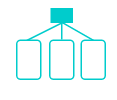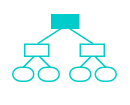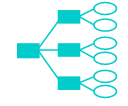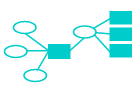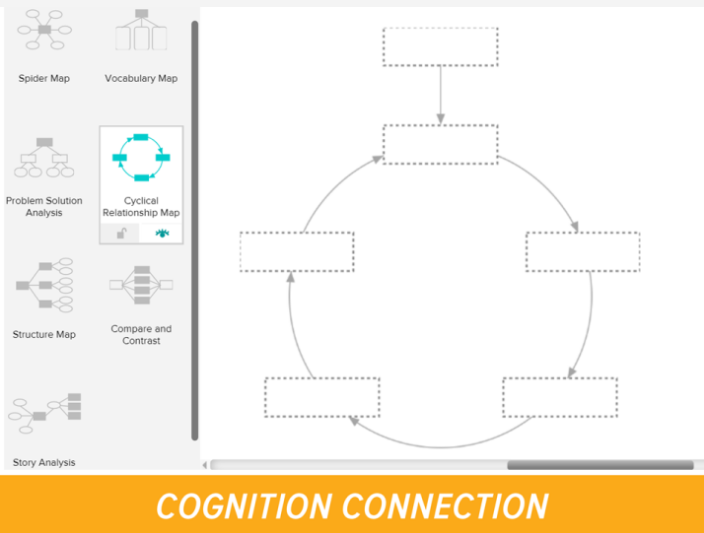Make-a-Map Templates
When students create concept maps, they explore, organize and link information seamlessly, deepening their understanding or knowledge of a topic while relating it to new concepts. All concept maps are made up of nodes with words, questions, ideas, etc. and labeled links between to show how key concepts are connected.
BrainPOP’s Make-a-Map tool invites students to create their own concept maps as well as provides map templates (see below) that they can use as guides for how to construct or visually organize a concept map for brainstorming, note-taking, researching, creative problem solving, and more. With Make-a-Map, students can organize content from the movies, including keywords, images, and screenshots from the movie to visually represent their knowledge and make connections between the information.
Following are descriptions of each map template in Make-a-Map and tips for using them as guides for how to visually represent and organize concept maps in different ways and for a range of uses:
Spider Map
A spider map has node in the center for the main idea or topic. Related details surround the central topic in their own subnodes. Details include ideas, words, examples etc. associated with the main idea. Spider maps can grow by adding nodes around each subtopic and so on. Spider maps are helpful for brainstorming before teaching a topic. You can use spider maps to assess students’ prior knowledge and/ or as a post assessment to identify students’ understanding after learning about a topic. They’re also an effective tool for planning writing.
Students use a spider map to
- Brainstorm what they know about a topic
- Organize information without a hierarchical structure
- Plan and organize for writing
Vocabulary Map
A vocabulary map features a word or concept in the top node. The associated nodes below are for identifying words and ideas associated with the featured word or concept. Vocabulary maps are useful across the curriculum from identifying relationships between vocabulary words to showing relationships between science concepts or events in history. Students can add nodes for related words or ideas. Encourage students to share their thinking by presenting their maps to the class, and explaining their rationale for placing words and concepts where they did and describing the relationship between them. Comparing and contrasting vocabulary maps featuring the same word or concept can broaden students thinking about a topic.
Students use a vocabulary map to
- Illustrate relationships between words or concepts
- Identify synonyms and/or antonyms
- Identify concepts related to featured word
- Visualize relationship between a words and multiple definitions
- Plan and organize for writing
This concept map has many uses, including identifying solutions to a problem. The main problem appears in the node at the top. Branching off the problem are potential solutions. Additional effects are branches off of the solutions. The multiple solution nodes encourage learners to consider more than one solution to a given problem. This type of concept map helps learners break down a problem by starting broadly at the top and drilling down to the details, making it more manageable to solve.
Students use a problem/solution analysis map to
- Identify problems and solutions
- Identify cause and effect
- Sort or classify items
- Outline steps in a plan
- Brainstorm outcomes
- Plan and organize for writing
A cycle map illustrates a sequence of events in a specific order and the relationship of those events to each other. A cycle map does not lead to a final outcome, but instead repeats through a cycle. Cycle map are most useful when learning science concepts such as the life cycle of a living organism or a cycle in nature, such as rock or water cycle. It can be useful for some social studies topics, too, such as how money moves through an economy. Use a cycle map to encourage students to recall major events in a process and their relationship to each other.
Students use a cyclical map to
- Illustrate sequence of events in a cycle
- Recognize the relationship between events in a cycle
- Plan and organize for writing
Structure Map
A structure map has many uses, and is similar to the Problem/Solution Analysis. One of the most common uses is for decision making. The issue to decide is stated in the node to the left. The possible decisions or alternatives branch out from the issue, and the pros and cons of each decision branches from that decision. Students can then compare and contrast the consequences of each alternative to make the best possible decision.
Students use a structure map to
- Support decision making
- Identify cause and effect
- Identify problem and solution
- Sort or classify items
- Outline steps in a plan
- Brainstorm outcomes
- Plan and organize for writing
Compare and contrast maps enables learners to identify similarities and differences between related concepts or ideas. They can then use the information to make decisions, evaluate concepts, write an essay, or as way to deepen their knowledge about a topic. Compare and contrast maps are useful across the curriculum: comparing/contrasting animals in science, communities in social studies, geometric shapes in math, and comparing characters or plot in a novel in English.
Students use a compare and contrast map to
- Identify how two or more concepts are alike and different
- Understand two positions of a debate
- Make decisions
- Evaluate information
- Plan and organize for writing
A story analysis can helps students understand a story they’ve read and it equally useful for planning their own writing. At the center of the map is the title of the story. Stemming from there are the story elements: setting, character, plot, conflict, and resolution. Branching from each are details about the element, such as different settings, events in the plot, names and personality traits of characters, and notes on the conflict or problem and resolution. Examining story elements helps students understand and identify a story’s theme or moral.
Students use a story analysis map to
- Understand a story they’ve read
- Write a story
- Summarize a story
- Identify a story’s theme or moral

